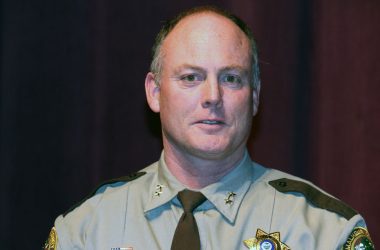Vale –– The wildfire season is likely to get off to a slower start than usual in Malheur County because of a wet spring and cooler temperatures, but might turn to normal or above normal fire activity by the end of July, according to Oregon state climatologist Larry O’Neill.
Although precipitation across Oregon hasn’t significantly shifted over time, Malheur County received more than average rain this year. The increase in rain this spring finally cleared Malheur County of drought, which has persisted in the region for more than two decades.
While the end of the drought this year is a positive sign, the risk of wildfires across the county still remains high, according to climate scientists and fire experts in Oregon.
The amount of land burned by fires has increased in the last 20 years, said Al Crouch, fire mitigation specialist at the Bureau of Land Management in Vale. He said the region has experienced hotter and drier weather over the last several years while increasing stocks of invasive species are replacing sagebrush and native grasses.
Though yearly weather patterns remain unpredictable, O’Neill said, the incidence of hotter and drier summers is escalating over time. According to Erica Fleishman, director of Oregon Climate Change Research Institute, temperature is generally a greater factor in calculating fire risk, because hotter temperatures can quickly dry up the rangeland, creating fine fuels for fire.
Fleishman said that the winter and spring conditions were great for cheatgrass, a rapidly spreading invasive species.
“When they dry out, they tend to turn into fine fuels and they are highly flammable,” she said. “When you get large areas where cheatgrass and other non-native grasses are dominant, fires spread quite rapidly in those areas.”
“Even a little cheatgrass in the landscape can actually lead to more fire risk,” O’Neill said.
In recent years, BLM Vale has engaged in multiple projects that decrease wildfire fuels to create a fire-resilient landscape. Dave LaChapelle, chief fuels specialist at BLM Vale, said that his team is working on constructing fuel breaks to check rampant fires and seeding native grass on rangelands previously colonized by cheatgrass.
This year, LaChapelle’s team treated almost 20,000 acres in Malheur county.
“That’s an increase from the past,” he said. “We want to keep pushing that figure up to 25,000, to 30,000 acres of annual treatments,” which include cutting juniper, another invasive species, and prescribed fires to reduce fuel.
“The increased moisture that we had is definitely a double-edged sword,” Crouch said. “It’s great for rangeland health. It’s good for our perennial grasses and our brush. But it could pose a fire problem later with a heavy fuel load.”
Response to wildfires
Wildfires are a natural part of rangelands. However, changing weather and climate conditions can make them very unpredictable.
“Wildfire seasons are different from year to year,” said Jess Tolman, fire defense district chief for Malheur County. “We say, ask after the fire season how this year’s going to be.”
A major reason for increased fires, according to both scientists and government officials, was the increase in human-caused ignitions over time.
“There has been just more contact between humans and the natural environment. There have been more accidents, more negligence or even purposeful actions of ignition, so all those together have greatly increased the number of fires on the landscape,” O’Neill said.
While people cannot control weather patterns, Fleishman said, they can take steps to control sources of ignition, such as controlling debris burning or opting to use camp stoves instead of starting campfires.
Fire officials, including Ontario Fire Chief Clint Benson, expect this year to be a “typical, dry, busy fire season.” Due to the open nature of the range landscape, Benson worries about the effects of high winds on wildfires.
“Any time we have fire with high wind, the probability of that getting out of control is great,” he said. “With a small fire department, getting something out of hand is worrisome.”
However, small fire departments receive a lot of assistance from BLM as well as other fire departments. Benson, who is also the chief of Ontario’s Rural Fire Protection District, said that rural fire protection associations (RFPAs) are essential in providing support to local fire stations.
Such associations are volunteer groups of ranchers and farmers who are knowledgeable about their land and can provide initial support for fighting fires. Because they are scattered all over the county, they are usually the first responders to remote fires.
“We catch about 98% of our fires. It’s just that 2% that get larger and those are the ones that you see on TV,” said Brent Meisinger, fire operations chief at BLM Vale.
Meisinger said through recent federal funding, the BLM has access to more resources to fight fires, including more than 150 firefighters and management staff during the fire season and aircraft, which have assisted with swift response to fires.
“If we can get the aviation assets up in the air and they can start dumping retardant to get an anchor going for our folks when they get there, then they have a higher chance of catching the fires,” Meisinger said.
While the number of active BLM firefighters isn’t great, Meisinger said, “if you account for our rural departments or RFPAs, they really bolster our organization.”
BLM Vale recently updated its Community Wildfire Protection Plan (CWPP) for Malheur County, addressing wildfire issues in the county and ways to prevent risk, and provide citizens an opportunity to voice concerns.
“We’re doing more work on the ground, face to face with our constituents and all of the folks that we cooperate with,” Crouch said.
“Prepare for the worst”
Crouch warns people against believing that this year’s rain will reduce the incidence of fire events, because conditions can change rapidly with the onset of hot and dry weather.
“Regardless of what conditions we have, we’re going to prepare to the highest level we possibly can. We’re always going to prepare for the worst,” he said.
“This year is a bit of an abnormal year. It is wetter than we’ve experienced in the last 10 to 20 years in the region,” O’Neill said. “I think people should enjoy that while still practicing the culture of being fire safe.”
NEWS TIP? Send an email to [email protected].
HOW TO SUBSCRIBE – The Malheur Enterprise delivers quality local journalism – fair and accurate. You can read it any hour, any day with a digital subscription. Read it on your phone, your Tablet, your home computer. Click subscribe – $7.50 a month.




